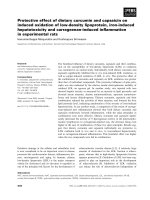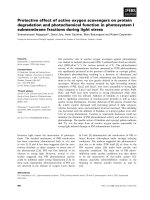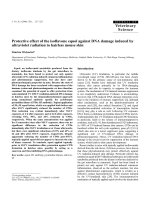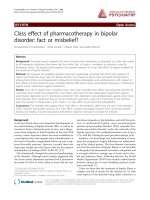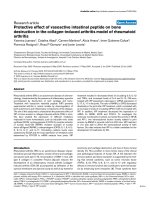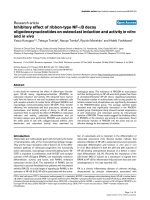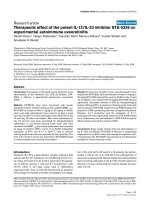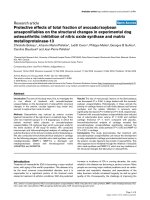Báo cáo y học: "Protective effect of budesonide/formoterol compared with formoterol, salbutamol and placebo on repeated provocations with inhaled AMP in patients with asthma: a randomised, double-blind, cross-over study" ppsx
Bạn đang xem bản rút gọn của tài liệu. Xem và tải ngay bản đầy đủ của tài liệu tại đây (602.51 KB, 9 trang )
Aalbers et al. Respiratory Research 2010, 11:66
/>Open Access
RESEARCH
BioMed Central
© 2010 Aalbers et al; licensee BioMed Central Ltd. This is an Open Access article distributed under the terms of the Creative Commons
Attribution License ( which permits unrestricted use, distribution, and reproduction in
any medium, provided the original work is properly cited.
Research
Protective effect of budesonide/formoterol
compared with formoterol, salbutamol and
placebo on repeated provocations with inhaled
AMP in patients with asthma: a randomised,
double-blind, cross-over study
René Aalbers
1
, Martin Boorsma
2
, Hanneke J van der Woude
1
and René E Jonkers*
3
Abstract
Background: The budesonide/formoterol combination is successfully used for fast relief of asthma symptoms in
addition to its use as maintenance therapy. The temporarily increased corticosteroid dose during increasing inhaler use
for symptom relief is likely to suppress any temporary increase in airway inflammation and may mitigate or prevent
asthma exacerbations. The relative contribution of the budesonide and formoterol components to the improved
asthma control is unclear.
Methods: The acute protective effect of inhaled budesonide was tested in a model of temporarily increased airway
inflammation with repeated indirect airway challenges, mimicking an acute asthma exacerbation. A randomised,
double-blind, cross-over study design was used. Asthmatic patients (n = 17, mean FEV
1
95% of predicted) who
previously demonstrated a ≥30% fall in forced expiratory volume in 1 second (FEV
1
) after inhaling adenosine 5'-
monophosphate (AMP), were challenged on four consecutive test days, with the same dose of AMP (at 09:00, 12:00 and
16:00 hours). Within 1 minute of the maximal AMP-induced bronchoconstriction at 09:00 hours, the patients inhaled
one dose of either budesonide/formoterol (160/4.5 μg), formoterol (4.5 μg), salbutamol (2 × 100 μg) or placebo. The
protective effects of the randomised treatments were assessed by serial lung function measurements over the test day.
Results: In the AMP provocations at 3 and 7 hours after inhalation, the budesonide/formoterol combination provided
a greater protective effect against AMP-induced bronchoconstriction compared with formoterol alone, salbutamol and
placebo. In addition all three active treatments significantly increased FEV
1
within 3 minutes of administration, at a time
when inhaled AMP had induced the 30% fall in FEV
1
.
Conclusions: A single dose of budesonide/formoterol provided a greater protective effect against inhaled AMP-
induced bronchoconstriction than formoterol alone, both at 3 and at 7 hours after inhalation. The acute protection
against subsequent bronchoconstrictor stimuli such as inhaled AMP and the rapid reversal of airway obstruction
supports the use of budesonide/formoterol for both relief and prevention in the treatment of asthma.
Trial Registration: ClinicalTrials.gov number NCT00272753
Background
The short-acting β
2
-agonist salbutamol is widely used as
first-line treatment in the management of acute broncho-
constriction in asthma because of its fast onset of action
[1]. The long-acting β
2
-agonist formoterol has an onset of
effect that is comparable with that of salbutamol [2] and,
when used as reliever therapy, has proven to be superior
to terbutaline and salbutamol in improving asthma con-
trol and preventing asthma exacerbations [3-5]. The com-
bination of budesonide and formoterol in one inhaler,
* Correspondence:
3
Department of Pulmonary Diseases, Academic Medical Center, Amsterdam,
T
he Netherlands
Full list of author information is available at the end of the article
Aalbers et al. Respiratory Research 2010, 11:66
/>Page 2 of 9
used as maintenance treatment, improved asthma control
compared with a similar or higher dose of an inhaled cor-
ticosteroid (ICS) alone [6,7]. Furthermore, budesonide/
formoterol is also effective in situations of acute and
severe bronchoconstriction [8,9], indicating that it is
effective as a reliever therapy. Clinical studies have sub-
stantiated that budesonide/formoterol can be used as
both maintenance and reliever therapy, resulting in
improved asthma control and an additional reduction in
exacerbation frequency compared with maintenance
therapy plus a separate bronchodilator for relief [10-14].
The effectiveness of this novel treatment regimen, where
patients use budesonide/formoterol as their only medica-
tion, is thought to be the result of a rapid increase in ICS
dose at the earliest onset of symptoms [15].
A single dose of an ICS is thought to have limited bron-
chodilating effects and some immediate bronchoprotec-
tive effect [16,17]. In addition, an ICS has a
vasoconstrictor effect in the airway mucosa, which can be
measured within hours of administration [18].
Inhaled adenosine 5'-monophosphate (AMP) induces
rapid degranulation of airway mast cells leading to bron-
choconstriction and airway oedema and is, therefore,
considered to mimic acute asthma attacks caused by
allergen, cold air or exercise [19,20]. Bronchodilators can
reverse AMP-induced bronchoconstriction and can also
immediately protect against AMP-induced bronchocon-
striction [21-23]. Long-term ICS treatment has a protec-
tive effect on bronchial hyperresponsiveness, as
measured with inhaled AMP [24], but an ICS has also a
small immediate protective effect against AMP induced
bronchoconstriction, which lasts for several hours
[25,26].
In daily life, patients with asthma can be repeatedly
exposed to allergic and non-specific triggers resulting in
airway constriction and asthma attacks. The present
study was, therefore, designed to assess the protective
effect of a single low dose of budesonide/formoterol with
that of β
2
-agonist treatment only (formoterol or salbuta-
mol) and placebo against repeated exposure to an indi-
rect stimulus, AMP.
Materials and methods
Patients
Outpatients were included if they were: aged between 18
and 55 years with a diagnosis of asthma [1], had an FEV
1
of >60% of predicted (26), used an inhaled corticosteroid
in a dose of ≥ 100 μg daily, a provocative concentration of
AMP causing a 20% fall in FEV
1
(PC
20
-AMP) ≤160 mg/
ml, and a demonstrated fall in FEV
1
of >30% upon contin-
uation of the AMP provocation. Patients had to be able to
use and inhale correctly through Turbuhaler
®
and a pres-
surised metered-dose inhaler (pMDI) connected to a
large volume spacer device (Volumatic
®
); inhalation tech-
nique was practised until correct.
Patients were excluded from the study if, within 6
weeks prior to enrolment, they had used systemic corti-
costeroids, had experienced an asthma exacerbation or
changed their ICS dose. Female patients who were preg-
nant, planning pregnancy, breastfeeding or not using an
adequate method of contraception were also excluded.
Patients were asked to avoid strenuous exercise, smoking
and consumption of caffeine-containing beverages in the
morning prior to the test days and throughout each of the
test days. The study was performed in accordance with
the ethical principles that have their origin in the Decla-
ration of Helsinki and in accordance with Good Clinical
Practice guidelines. The study was approved by the Medi-
cal Ethics Committees of both hospitals (Medical Ethics
Committee Martini Ziekenhuis, reference number 2003-
44 and Medical Ethics Committee Academic Medical
Centre Amsterdam, reference number MEC 05/074.
Written informed consent was obtained from all patients
prior to their enrolment.
Study design
This randomised, double-blind, double-dummy, placebo-
controlled, cross-over study (study code BN-00S-0022,
NIH ClinicalTrials.gov trial data base number
NCT00272753) was conducted at two centres. The study
comprised an initial enrolment visit at the start of the
run-in period, a short visit at the end of the run-in period
and four test days that were all separated by 5-14 days.
The assessments on each test day are graphically shown
in Figure 1.
At enrolment patients underwent an AMP provocation
test with doubling concentrations of AMP increasing
from 0.04 mg/ml to 160 mg/ml, inhaled during 2 minutes
tidal breathing at intervals of 5 minutes until a fall from
baseline FEV
1
of ≥30% was demonstrated. Hereafter, ICS
and bronchodilator treatment was standardised for the
remainder of the study as once daily (in the evening) two
inhalations of budesonide/formoterol 160/4.5 μg per dose
(160/4.5 μg represents the delivered dose, this is 200/6 μg
Figure 1 Study design of the Test Days.
Aalbers et al. Respiratory Research 2010, 11:66
/>Page 3 of 9
per metered dose, Symbicort
®
Turbu ha le r
®
, AstraZeneca,
Sweden) and with terbutaline 250 μg per dose (Bricanyl
®
Tu rb u hal er
®
, AstraZeneca, Sweden) for "as needed" use.
At the second visit, and after omitting the previous eve-
ning dose of budesonide/formoterol and abstaining from
terbutaline use for 6 hours, responsiveness to inhaled
AMP was confirmed in an abbreviated AMP provocation
test, giving only the last four AMP doses that were given
at enrolment (this was interrupted if FEV
1
decreased
≥30%). Thereafter, on each of the subsequent four test
days, three abbreviated AMP challenges were performed,
commencing at approximately 09:00, at 12:00 and at
16:00 hours.
Test-day assessments
The AMP provocation tests were only performed when
the baseline FEV
1
at 09:00 hours differed <15% from the
value at enrolment and when FEV
1
prior to each test was
>60% of predicted. At the moment of completing the first
AMP challenge on the test days, thus when there was an
approximate 30% fall in FEV
1
and within one minute of
inhaling the last AMP dose, one of the double-blind treat-
ments was inhaled: one inhalation of budesonide/formot-
erol 160/4.5 μg (via Turbuhaler
®
), one inhalation of
formoterol 4.5 μg (via Turbuhaler
®
), two inhalations of
salbutamol 100 μg (via pMDI connected to Volumatic), or
placebo. On all occasions one inhalation from Turbu-
haler
®
and 2 inhalations from the pMDI were inhaled.
Patients were randomised so that half of them used Tur-
buhaler
®
for their first inhalation on each of the four test
days and half used the pMDI first. Inhalers containing
placebo or active medication had an identical appearance.
The primary (FEV
1
) and secondary parameters (mean
forced expiratory flow between 25% and 75% of forced
vital capacity [FEF
25-75
] and the modified Borg scale
[range 0-10] for perceived breathlessness [27]) were mea-
sured during the provocation test and at 1, 3, 5, 10, 15, 30,
45 and 60 minutes after each AMP provocation as well as
hourly in between AMP provocations.
The highest values of three attempts of FEV
1
and FEF
25-
75
were recorded [28] apart from during the first 20 min-
utes following AMP provocation when single assess-
ments were made. During the abbreviated provocation
itself, the lowest FEV
1
(for safety reasons not the highest
value was used) and the highest FEF
25-75
of single assess-
ments at 30 and 90 seconds after each 2-minute AMP
inhalation were recorded.
Statistical analysis
The primary aim of the study was to compare the magni-
tude of the bronchoprotective effects of budesonide/for-
moterol in comparison with formoterol alone. This was
assessed as: (1) the maximal % fall in FEV
1
in the 16:00
hours AMP provocation; (2) the mean % fall in FEV
1
(cal-
culated from the Area Under the FEV
1
Curve (AUC
0-60
)
from 0 to 60 minutes after the 16:00 hours AMP provoca-
tion); (3) the maximal % fall in FEV
1
in the 12:00 hours
AMP provocation; and (4) the Area Under the Curve on
the entire Test Day, from 09:00 to 17:00 hours (AUC
9-17
)
for FEV
1
. For the secondary parameters FEF
25-75
and Borg
Score only the AUC
9-17
was calculated and compared.
The % fall in FEV
1
in the 12:00 and 16:00 hours provoca-
tion was expressed as % change from the baseline FEV
1
,
measured immediately prior to that provocation to com-
pensate for remaining bronchodilation from the study
drug or remaining bronchoconstriction from AMP. For
AUC
9-17
, the FEV
1
and FEF
25-75
values were expressed as
% change from the test-day baseline value at 09:00 hours,
the Borg score was expressed as absolute changes from
the test-day baseline.
The onset of relief of bronchoconstriction by budes-
onide/formoterol after the first AMP provocation at
09:00 hours was expressed as the increase from the low-
est FEV
1
after AMP to the FEV
1
at 3 minutes with both
expressed as a % of baseline FEV
1
.
PC
20
-AMP values were calculated by interpolation
from a log cumulative concentration versus % decrease in
FEV
1
response curve.
The AMP-induced change in FEV
1
in the AMP provo-
cation (as the ratio lowest/baseline FEV
1
) was compared
between treatments in an additive analysis of variance
model with subject, period and treatment as fixed factors
and the test-day baseline FEV
1
as covariate. Mean
changes in FEV
1
and two-sided 95% confidence intervals
were calculated. Mean treatment differences were esti-
mated by least-squares means resulting from this model.
Other parameters were also analysed in this way. Of the
above mentioned four ways to estimate the bronchopro-
tective effect, one parameter was chosen as the primary
parameter in the power calculation prior to the study and
in the statistical analysis: maximal % fall in the 16:00
hours AMP provocation. For this parameter, all six com-
parisons between the four treatments were tested. For all
other parameters, statistical comparisons were restricted
to the comparisons of budesonide/formoterol versus the
three other treatments.
This study design with three AMP provocations on one
each test day had not been used before. Therefore, sample
size calculation was performed using data from a
repeated cold air and exercise challenge study [29]. With
an assumed standard deviation of 6.8% for the fall in the
third AMP provocation and a power of 80%, a difference
in the % fall in FEV
1
of 4.5% would be detectable with 20
patients.
Aalbers et al. Respiratory Research 2010, 11:66
/>Page 4 of 9
Results
Patients
Eighteen patients were randomised. One patient was
withdrawn on the first test day prior to study treatment
because of a baseline FEV
1
below 85% of the FEV
1
at
enrolment, leaving 17 patients who received at least one
dose of the study treatments. As a result of expiry of study
drugs, no additional patients could be enrolled and two
patients had to be withdrawn after completing two or
three test days, respectively. Three test days were post-
poned because of unstable baseline lung function or use
of non-allowed medication. No test day had to be inter-
rupted for administration of bronchodilators. A summary
of demographic and clinical data at enrolment is pre-
sented in Table 1. Baseline FEV
1
, the actual doses of AMP
given and the resulting decrease in FEV
1
and increase in
Borg dyspnoea score prior to study treatment inhalation
were very similar on each of the four test days (Table 2).
Bronchoprotective effects
For the primary endpoint, the mean maximal fall after the
third AMP provocation performed at 16:00 hours (i.e. 7
hours after treatment), was 15.7% after budesonide/for-
moterol, numerically (but not significantly) less than the
20.1% fall after formoterol (p = 0.24) and significantly less
than the 29.8% and 31.9% fall after salbutamol (p =
0.0005) and placebo (p < 0.0001), respectively (Table 3).
Formoterol alone provided significantly more protection
(smaller fall in FEV
1
) than salbutamol (p = 0.014) and pla-
cebo (p = 0.0025) but salbutamol did not do better than
placebo at 7 hours (p = 0.57).
The mean fall in FEV
1
in the 60 minutes after the 16:00
hours AMP challenge (AUC
0-60
) was significantly smaller
following budesonide/formoterol pre-treatment than that
after formoterol (p = 0.045), salbutamol (p = 0.0001) and
placebo (p < 0.0001) (Table 3).
All active treatments attenuated the bronchoconstric-
tion by the AMP challenge at 3 hours after inhalation (i.e.
12:00 hours). The maximal % fall in FEV
1
following
budesonide/formoterol (8.8%) was significantly lower
than that after formoterol (17.0%, p = 0.023), salbutamol
(20.1%, p = 0.0028) and placebo (27.1%, p < 0.0001) (Table
3).
Profile of FEV
1
, FEF
25-75
and Borg score over the day
The time course of FEV
1
over the entire test day is pre-
sented in Figure 2. Initially, FEV
1
was highest following 2
inhalations of salbutamol, but from 2 hours after inhala-
tion onwards, FEV
1
was highest following budesonide/
formoterol. When calculated over the entire test day (as
FEV
1
AUC
9-17
), the FEV
1
after budesonide/formoterol
was significantly greater than that after formoterol (p =
0.033), salbutamol (p = 0.0011) and placebo (p < 0.0001,
Table 4).
The time course of FEF25-75 over the test day is shown
in Figure 3. From 45 minutes onwards, FEF25-75 was
highest following budesonide/formoterol. The FEF25-75
AUC9-17 for budesonide/formoterol tended to be greater
than that after formoterol (p = 0.070), and differed signif-
icantly from that after salbutamol (p = 0.0005) and pla-
cebo (p < 0.0001).
The time course of Borg dyspnoea score over the test
day is shown in Figure 4. Dyspnoea recovered quickly fol-
lowing all three active treatments. In the third AMP prov-
ocation salbutamol had lost its protective effect as
assessed with the subjective Borg score whereas both for-
moterol and budesonide/formoterol had a residual pro-
tective effect against AMP-induced dyspnoea. The Borg
score AUC
9-17
after budesonide/formoterol was, however,
not significantly different compared with formoterol (p =
0.57) or salbutamol (p = 0.37) but differed significantly
from placebo (p = 0.0039).
Immediate bronchodilating effect
All three active treatments rapidly reversed the AMP-
induced bronchoconstriction at 09:00 hours. At 3 min-
utes after inhalation, the single dose of budesonide/for-
moterol induced an increase in FEV
1
of 15.2%, which was
statistically significant larger than the 1.7% increase
observed after placebo (p < 0.0001), and was comparable
to the increase observed with formoterol (13.2%, p = 0.44)
but smaller than the 21.5% increase seen after two doses
of salbutamol (p = 0.023).
Table 1: Patient baseline demographics
Characteristic Value
Sex: Male/Female, n 6/11
Mean age, years (range) 37.2 (20-53)
Median time since asthma
diagnosis, years (range)
20.2 (3-42)
Mean inhaled corticosteroid
dose prior to the study, μg
(range)
553 (200-800)
User of long-acting β
2
-
agonist prior to the study
14
Mean FEV
1
, L (range) 3.26 (2.11-4.69)
Mean FEV
1
, % predicted
(range)
94.6 (63-126)
Geometric mean PC
20
-AMP,
mg/ml (range)
2.64 (0.08-125)
FEV
1
: forced expiratory volume in 1 second; PC
20
: provocative
concentration of adenosine 5'-monophoshate (AMP) causing a
20% fall in FEV
1
.
Aalbers et al. Respiratory Research 2010, 11:66
/>Page 5 of 9
Discussion
Overall, a single low dose of the combination budes-
onide/formoterol (160/4.5 μg) had a greater protective
effect at 3 and 7 hours after inhalation than a single dose
of formoterol 4.5 μg alone, although the difference
between these two treatments did not meet the pre-
defined primary endpoint of the maximum % fall in FEV
1
7 hours after the first AMP challenge. As expected, both
treatments with formoterol showed a superior duration
of protection relative to the reference treatment salbuta-
mol, which has a shorter half-life of action. These data
also support an immediate and lasting additive effect of
the inhaled corticosteroid budesonide in protecting
against an indirect airway stimulus in asthmatics and
provide further rationale for the use of the combination
on an as needed basis to prevent further deterioration in
case of an asthma exacerbation.
Our study is the first to substantiate the magnitude and
duration of the additive protective effect against AMP-
induced bronchoconstriction of a low dose of an inhaled
corticosteroid on top of a long-acting bronchodilator.
Our data add to and are consistent with the previous
observation that a single dose of the inhaled corticoster-
oid fluticasone protects against AMP-induced bronchoc-
onstriction [25,26], and that the effect of a high dose lasts
for at least several hours [26]. In a recent study, the
budesonide/formoterol combination given immediately
after allergen provocation also proved superior to both
single components in preventing the late asthmatic reac-
tion as well as the associated increase in bronchial hyper-
responsiveness [30].
The study design was intended to mimic an acute
asthma exacerbation with multiple AMP provocation
tests on single test days. This gave us a unique opportu-
nity to test the contribution of different inhaled drugs,
acting via different mechanisms, in this situation. As with
every model it has its limitations and does not fully repre-
sent a real life asthma attack. Furthermore, because exac-
erbations can be precipitated by different exposures such
as viral infection or allergen exposure, different mecha-
nisms may be involved. In addition, the study was proba-
bly slightly underpowered as the sample size estimation
was 20, but only 17 patients received treatment and of
those only 15 patients had full data available. The additive
effect of budesonide on the primary endpoint % fall in
FEV
1
at 7 hours was close to the smallest detectable dif-
ference according to the pre-study power calculation
(4.4% vs. 4.5% fall) but the standard deviation in the % fall
was larger than assumed (10.6% versus 6.8%). On the
other hand, for all 3 predefined secondary endpoints with
Table 2: Adenosine 5'-monophosphate provocation test data at 09:00 hours, immediately before administration of study
treatments
Treatment Baseline FEV1, before
provocation (L)
AMP dose (mg/ml) Fall in FEV1 after AMP
provocation (%)
Increase in Borg
dyspnoea score after
provocation
Budesonide/
formoterol
3.13 (0.80) 109 (184) 28.0 (14.0) 2.50 (1.40)
Formoterol 3.11 (0.86) 122 (193) 28.7 (12.2) 2.00 (1.35)
Salbutamol 3.03 (0.91) 110 (191) 31.6 (14.5) 2.91 (1.58)
Placebo 3.06 (0.89) 106 (186) 29.4 (10.6) 2.79 (1.57)
All data are presented as mean (SD); FEV
1
: forced expiratory volume in 1 second; AMP: adenosine 5'-monophoshate; AMP dose as cumulative
nebulized concentration.
Table 3: Protective effects of study treatments in repeated AMP provocations
Fall in FEV1 in AMP provoca-
tion at 3 hours (%)
Fall in FEV1 in AMP provoca-
tion at 7 hours (%)
AUC0-60-FEV1 in AMP
provocation at 7 hours (h.%)
Budesonide/formoterol 8.8 (4.0, 13.6) 15.7 (10.7, 20.8) -4.2 (- 8.6, 0.2)
Formoterol 17.0 (11.8, 22.1)* 20.1 (14.6, 25.5) -10.7 (- 15.4, -6.0)*
Salbutamol 20.1 (15.0, 25.2)
#
29.8 (24.4, 35.2)
$
-17.9 (- 22.5, -13.2)
$
Placebo 27.1 (22.3, 31.8)
$
31.9 (26.9, 36.9)
$
-19.9 (- 24.3, -15.6)
$
Data shown as Least Square Mean and 95% Confidence Interval; FEV
1
: forced expiratory volume in 1 second; AMP: adenosine 5'-
monophoshate; fall in FEV
1
as % from baseline prior to each AMP provocation; AUC
0-60
: Area Under the Curve for % change in FEV
1
from 0 to
60 minutes after AMP provocation; p-values from ANOVA, differences compared with budesonide/formoterol: *p < 0.05,
#
p < 0.01,
$
p < 0.001.
Aalbers et al. Respiratory Research 2010, 11:66
/>Page 6 of 9
multiple lung function testing the differences were statis-
tically significant.
Ideally, the study would have had an additional study
limb in which only budesonide would have been given.
This was considered too large a burden for the patients.
Additionally, it would not have added to answer our
research question on the additive bronchoprotective
effect of budesonide on top of the well established effect
of formoterol as relief medication.
To explain the observed additive protective effects of
budesonide over those of formoterol alone, the potential
immediate effects of a corticosteroid on the postulated
mechanisms of AMP-induced airway narrowing need to
be considered. AMP induces mast cell degranulation and
release of mediators leading to airway narrowing due to
smooth muscle constriction and mucosal edema as a
result of increased mucosal blood flow and increased
microvascular permeability [20]. AMP might also act on
adenosine receptors in vascular beds and neurosecretory
cells to induce mucosal edema directly. Because there is
no evidence that a single inhalation of a corticosteroid
reduces mast cell number or function, inhibition of mast
Table 4: Protective effects of study treatments in repeated AMP provocations over the entire Test Day
AUC9-17-FEV1
(h.%)
AUC9-17-FEF25-75
(h.%)
AUC9-17 - Borg
(h.units)
Budesonide/formoterol 20.9 (3.7, 38.1) 134 (69.8, 198) 0.21 (-1.64, 2.07)
Formoterol -6.4 (-25.0, 12.1)* 47.8 (-21.5, 117) -0.55 (-2.55, 1.45)
Salbutamol -23.6 (-41.9, -5.3)
$
-44.6 (-113, 23.8)
#
1.47 (-0.50, 3.45)
Placebo -61.0 (-77.9, -44.0)
$
-66.2(-130, 2.8)
$
4.20 (2.37, 6.03)
$
Data shown as Geometric Mean and 95% confidence interval; AUC
9-17
: Area Under the Curve from 09:00 to 17:00 hours, covering three AMP
provocations; changes relative to test-day baseline at 09:00 hours; FEV
1
: forced expiratory volume in 1 second; FEF
25-75
: forced expiratory flow
between 25% and 75% of forced vital capacity; comparisons by ANOVA, differences compared to budesonide/formoterol: *p < 0.05,
#
p < 0.01,
$
p < 0.001.
Figure 2 Mean FEV
1
over the test day with three AMP provocations followed by a single dose of budesonide/formoterol 160/4.5 μg (open
diamonds), formoterol 4.5 μg (open squares), salbutamol 2 × 100 μg (filled triangles) or placebo (crosses) immediately after the first AMP
provocation.
Aalbers et al. Respiratory Research 2010, 11:66
/>Page 7 of 9
cell mediator responses is a more likely explanation. In a
rat study airway microvascular permeability was shown
to be inhibited within several hours after single-dose cor-
ticosteroid administration [31]. In addition ICS induce a
rapid vasoconstriction by non-genomic effects in asth-
matic airways [32,33]. Apparently, these immediate
effects of an inhaled corticosteroid on the airway vascular
bed provide additional protective benefit over the func-
tional antagonism by formoterol against airway smooth
muscle contraction.
Although the latter may be considered a rationale for
combining budesonide and formoterol in a single inhaler
to be used also for acute asthma symptoms, the clinical
relevance might be questioned since the differences
between budesonide/formoterol and single formoterol in
Borg dyspnoea score over the entire test day were not sta-
tistically significant. However, this is most likely because
the Borg scores rapidly returned to symptom-free base-
line values in between AMP provocations, leaving little
room for further improvement. It can be hypothesized
that immediate bronchoprotection via multiple mecha-
nisms early during an imminent asthma attack may ame-
liorate symptoms to such an extent that a full-blown
asthma exacerbation is prevented. Support for this can be
found in the results of clinical trials that have shown
reduced exacerbation rates following use of budesonide/
formoterol as maintenance and reliever therapy [10-14]
and the efficacy of the combination in the emergency set-
ting [34,35].
In conclusion, the budesonide within the budesonide/
formoterol combination inhaler provides additional and
sustained protective effects against the external stimulus
inhaled AMP in comparison with formoterol alone. In
addition, the budesonide/formoterol combination pro-
vides immediate bronchodilation when inhaled in a state
of bronchoconstriction. This supports the use of this
combination for both relief and prevention of asthma
symptoms.
Figure 3 Mean FEF
25-75
over the Test Day with three AMP provocations followed by a single dose of budesonide/formoterol 160/4.5 μg
(open diamonds), formoterol 4.5 μg (open squares), salbutamol 2 × 100 μg (filled triangles) or placebo (crosses) immediately after the first
AMP provocation.
Aalbers et al. Respiratory Research 2010, 11:66
/>Page 8 of 9
Abbreviations
AMP: adenosine 5'-monophosphate; AUC
0-60
: Area Under the Curve for the 60
minutes after the provocation at 16:00 hours; AUC
9-17
: Area Under the Curve
from 09:00 to 17:00 hours; FEF
25-75
: mean forced expiratory flow between 25%
and 75% of forced vital capacity; FEV
1
: forced expiratory volume in 1 second;
ICS: inhaled corticosteroid; PC
20
: a provocative concentration of AMP causing a
20% fall in FEV
1
; pMDI: pressurised Metered Dose Inhaler.
Competing interests
RA has received in the last five years honoraria for attendance at advisory
boards from AstraZeneca and Novartis totalling €10,000. His department has
received the last five years grants from AstraZeneca, totalling to €70,000.
MB is a full-time employee of AstraZeneca, The Netherlands.
HJW has no conflicts of interest.
REJ has received in the last five years travel grants from Bayer, MSD, Boehringer
Ingelheim and GSK for attending international congresses.
Authors' contributions
RA and MB conceived and designed the study. RA, HJW and REJ executed the
clinical part of the study. MB supervised the statistical analysis. RA, MB and REJ
drafted the manuscript. All authors read and approved the final manuscript
prior to submission.
Acknowledgements
We would like to thank T.H. Winter, S. Lone-Latif and S.B. Denijs for performing
the spirometry assessments and Pierre Gobbens for providing statistical sup-
port. Ian Wright performed kind editorial assistance. This study (Study code BN-
00S-0022) was financed by AstraZeneca, The Netherlands.
Author Details
1
Department of Pulmonary Diseases, Martini Hospital, Groningen, The
Netherlands,
2
Medical Department, AstraZeneca, Zoetermeer, The Netherlands
and
3
Department of Pulmonary Diseases, Academic Medical Center,
Amsterdam, The Netherlands
References
1. Global Initiative for Asthma Global Strategy for Asthma Management and
Prevention 2008 []. Global Initiative for Asthma
(GINA)
2. Politiek MJ, Boorsma M, Aalbers R: Comparison of formoterol,
salbutamol and salmeterol in methacholine-induced severe
bronchoconstriction. Eur Respir J 1999, 13:988-992.
Received: 8 January 2010 Accepted: 28 May 2010
Published: 28 May 2010
This article is available from: 2010 Aalbers et al; licensee BioMed Central Ltd. This is an Open Access article distributed under the terms of the Creative Commons Attribution License ( which permits unrestricted use, distribution, and reproduction in any medium, provided the original work is properly cited.Respiratory Research 2010, 11:66
Figure 4 Mean Borg score over the Test Day with three AMP provocations followed by a single dose of budesonide/formoterol 160/4.5 μg
(open diamonds), formoterol 4.5 μg (open squares), salbutamol 2 × 100 μg (filled triangles) or placebo (crosses) immediately after the first
AMP provocation.
Aalbers et al. Respiratory Research 2010, 11:66
/>Page 9 of 9
3. Tattersfield AE, Lofdahl C-G, Postma DS, Eivindson A, Schreurs AG,
Rasidakis A: Comparison of formoterol and terbutaline for as-needed
treatment of asthma: a randomised trial. Lancet 2001, 357:257-261.
4. Pauwels RA, Sears MR, Campbell M, Villasante C, Huang S, Lindh A:
Formoterol as relief medication in asthma: a worldwide safety and
effectiveness trial. Eur Respir J 2003, 22:787-794.
5. Cheung D, van Klink HCJ, Aalbers R, for the OZON study group: Improved
lung function and symptom control with formoterol on demand in
asthma. Eur Respir J 2006, 27:504-510.
6. Zetterström O, Buhl R, Mellem H, Hedman J, O'Neill S, Ekstrom T:
Improved asthma control with budesonide/formoterol in a single
inhaler, compared with budesonide alone. Eur Respir J 2001, 18:262-268.
7. Scicchitano R, Aalbers R, Ukena D, Manjra A, Fouquert L, Centanni S,
Boulet LP, Naya IP, Hultquist C: Efficacy and safety of budesonide/
formoterol single inhaler therapy versus a higher dose of budesonide
in moderate to severe asthma. Curr Med Res Opin 2004, 20:1403-1418.
8. Boonsawat W, Charoenratanakul S, Pothirat C, Sawanyawisuth K,
Seearamroongruang T, Bengtsson T, Brander R, Selroos O: Formoterol
(OXIS) Turbuhaler as a rescue therapy compared with salbutamol pMDI
plus spacer in patients with acute severe asthma. Respir Med 2003,
97:1067-1074.
9. Woude HJ Van der, Boorsma M, Bergqvist PBF, Winter TH, Aalbers R:
Budesonide/formoterol in a single inhaler rapidly relieves
methacholine-induced moderate-to-severe bronchoconstriction.
Pulm Pharm Ther 2004, 17:89-95.
10. O'Byrne PM, Bisgaard H, Godard PP, Pistolesi M, Palmqvist M, Zhu Y:
Budesonide/formoterol combination therapy as both maintenance
and reliever medication in asthma. Am J Respir Crit Care Med 2005,
171:129-136.
11. Rabe KF, Pizzichini E, Ställberg B, Romero S, Balanzat AM, Atienza T:
Budesonide/formoterol in a single inhaler for maintenance and relief
in mild-to-moderate asthma: a randomized, double-blind trial. Chest
2006, 129:246-256.
12. Rabe KF, Atienza T, Magyar P, Larsson P, Jorup C, Lalloo UG: Effect of
budesonide in combination with formoterol for reliever therapy in
asthma exacerbations: a randomised controlled, double-blind study.
Lancet 2006, 368:744-753.
13. Kuna P, Peters MJ, Manjra AI, Jorup C, Naya IP, Martínez-Jimenez NE, Buhl
R: Effect of budesonide/formoterol maintenance and reliever therapy
on asthma exacerbations. Int J Clin Pract 2007, 61:725-736.
14. Bousquet J, Boulet LP, Peters MJ, Magnussen H, Quiralte J, Martinez-
Aguilar NE, Carlsheimer A: Budesonide/formoterol for maintenance and
relief in uncontrolled asthma vs. high-dose salmeterol/fluticasone.
Respir Med 2007, 101:2437-2446.
15. Gibson PG: Teaching old drugs new tricks: asthma therapy adjusted by
patient perception or noninvasive markers. Eur Respir J 2005,
25:397-399.
16. Gibson PG, Saltos N, Fakes K: Acute anti-inflammatory effects of inhaled
budesonide in asthma. A randomized controlled trial. Am J Respir Crit
Care Med 2001, 163:32-36.
17. Essen-Zandvliet EE, Hop WC, de Jong H, Ferwerda A, Kerrebijn KF: Minor
acute effect of an inhaled corticosteroid (budesonide) on bronchial
hyperresponsiveness to methacholine in children with asthma. Eur
Respir J 1993, 6:383-386.
18. Mendes ES, Pereira A, Danta I, Duncan RC, Wanner A: Comparative
bronchial vasoconstrictive efficacy of inhaled corticosteroids. Eur
Respir J 2003, 21:989-993.
19. Aalbers R, Kauffman HF, Koëter GH, Postma DS, de Vries K, de Monchy JGR:
Dissimilarity in methacholine and adenosine 5'-monophosphate
responsiveness 3 and 24 h after allergen challenge. Am Rev Respir Dis
1991, 144:352-357.
20. Polosa R, Holgate ST: Adenosine bronchoprovocation: a promising
marker of allergic inflammation in asthma? Thorax 1997, 52:919-923.
21. Ketchell RI, Jensen MW, Spina D, O'Connor BJ: Dose-related effects of
formoterol on airway responsiveness to adenosine 5'-monophosphate
and histamine. Eur Respir J 2002, 19:611-616.
22. Aziz I, Wilson AM, Lipworth BJ: Effects of once-daily formoterol and
budesonide given alone or in combination on surrogate inflammatory
markers in asthmatic adults. Chest 2000, 118:1049-1058.
23. Dahlén B, Lantz AS, Ihre E, Skedinger M, Henriksson E, Jörgensen L,
Ekström T, Dahlén SE, Larsson K: Effect of formoterol with or without
budesonide in repeated low-dose allergen challenge. Eur Respir J 2009,
33(4):747-53.
24. O'Connor BJ, Ridge SM, Barnes PJ, Fuller RW: Greater effect of inhaled
budesonide on adenosine 5'-monophosphate-induced than on
sodium-metabisulfite-induced bronchoconstriction in asthma. Am Rev
Respir Dis 1992, 146:560-564.
25. Ketchell RI, Jensen MW, Lumley P, Wright AM, Allenby MI, O'Connor BJ:
Rapid effect of inhaled fluticasone propionate on airway
responsiveness to adenosine 5'-monophosphate in mild asthma. J
Allergy Clin Immunol 2002, 110:603-606.
26. Luijk B, Kempsford RD, Wright AM, Zanen P, Lammers JWJ: Duration of
effect of single-dose inhaled fluticasone propionate on AMP-induced
bronchoconstriction. Eur Respir J 2004, 23:559-564.
27. Borg GA: Psychophysical bases of perceived exertion. Med Sci Sports
Exerc 1982, 14:377-381.
28. Quanjer PhH, Tammeling GJ, Cotes JE, Pedersen OF, Yernault JC: Lung
volumes and forced ventilatory flows. Report working party:
Standardisation of lung function tests European Community for steel
and coal. Official statement of the European Respiratory Society. Eur
Respir J 1993, 6(Suppl 16):5-40.
29. Vilsvik J, Ankerst J, Palmqvist M, Persson G, Schaanning J, Schwabe G:
Protection against cold air and exercise-induced bronchoconstriction
while on regular treatment with Oxis. Respir Med 2001, 95:484-490.
30. Duong ML, Gauvreau G, Watson R, Obminski G, Strinich T, Evans M: The
effects of inhaled budesonide and formoterol in combination and
alone when given directly after allergen challenge. J Allergy Clin
Immunol 2007, 119:322-327.
31. Boschetto P, Rogers DF, Fabbri LM, Barnes PJ: Corticosteroid inhibition of
airway microvascular leakage. Am Rev Respir Dis 1991, 143:605-609.
32. Horvath G, Wanner A: Inhaled corticosteroids: effects on the airway
vasculature in bronchial asthma. Eur Respir J 2006, 27:172-187.
33. Horvath G, Vasas S, Wanner A: Inhaled corticosteroids reduce asthma-
associated airway hyperperfusion through genomic and non-genomic
mechanisms. Pulm Pharm Ther 2007, 20:157-162.
34. Balanag VM, Yunus F, Yang PC, Jorup C: Efficacy and safety of
budesonide/formoterol compared with salbutamol in the treatment of
acute asthma. Pulm Pharm Ther 2005, 19:139-147.
35. Bateman ED, Fairal L, Lombardi DM, English R: Budesonide/formoterol
and formoterol provide similar rapid relief in patients with acute
asthma showing refractoriness to salbutamol. Respir Res 2006, 7:13.
doi: 10.1186/1465-9921-11-66
Cite this article as: Aalbers et al., Protective effect of budesonide/formoterol
compared with formoterol, salbutamol and placebo on repeated provoca-
tions with inhaled AMP in patients with asthma: a randomised, double-blind,
cross-over study Respiratory Research 2010, 11:66

